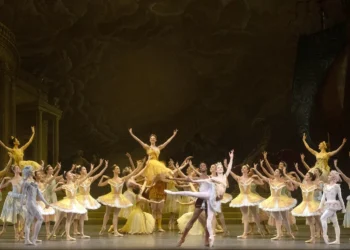Raffaella: A New Fairytale Ballet Review
March 2, 2025 | Digital
Friday, March 7 marked the online premiere of Raffaella: A New Fairytale Ballet, a heartfelt tribute to St. Louis Ballet dancer Raffaella Stroik who died in 2018 at the age of 23.
On the night of the ballet’s digital debut, over 540 users from across the globe logged onto their devices to watch it live. Three days later, Raffaella has garnered more than 5,100 views and continued comments of earnest praise.
The new fairytale ballet, which premiered on stage on June 29, 2024, at the Morris Performing Arts Center in South Bend, Indiana, is a joyous coming-of-age story following a talented young ballerina – Raffaella – as she navigates the universal complexities of dedication, decisions, and love.
It’s set in the fictional Italian village of San Michele on Lake Como, Italy during the 18th century, a scene brilliantly brought to life by Gabrielle Stroik Johnson. It was commissioned by Duncan and Ruth Stroik in memory of their daughter and is believed to be the largest crowdfunded ballet in history.
You may also like...
American Ballet Theatre Sylvia Review: Because Love is Worth Chasing For
In Sylvia, Ashton repeatedly uses grand jetés in the ballet not only to bring out the huntresses’ characters, but also...
ABT The Winter’s Tale Review: Familiar Steps, Fearless Chemistry
As The Winter's Tale unfolded, it was the combination of a large production team and the dancers’ deep commitment to...
Raffaella: A New Fairytale Ballet Review
While nearly every aspect of the ballet, from the story to the score, was created from the ground up, Raffaella is overwhelmingly familiar. Rooted in more traditional storytelling methods and performance styles, Raffaella favors a clear, coherent narrative over ingratiating athletic feats. And that’s not a criticism.
The cast relishes in the many (but perhaps prolonged) junctures for acting and leaning deeply into their characters.
Colorado Ballet’s Leah McFadden, for one, shines as the titular character. Her dancing is assured yet laced with a playful, almost innocent energy that emits a childlike sense of freedom and joy.
Paul Zusi, on the other hand, struggles to make the same impact as the Prince. He is a fine dancer of elegant lines and easy jumps, but he seems to lack the commanding presence his character requires.
While the ballet’s narrative largely plays out among the principals and featured dancers, the corps de ballet is no small part of the production. Comprised mostly of guest dancers, the corps makes a distinct impression with their individual technical skill and impeccably synchronized group work suggestive of a more (and personally much desired) extensive collaboration.
The true merit of this ballet, however, lies in its rich symbolism.
Raffaella Stroik was a devout Catholic. As such, elements of her faith are not-so-subtly interwoven throughout, appearing most poignantly in the rose motif (representing Raffaella’s devotion to St. Thérèse of Lisieux) and the climactic battle between the Prince and Ombroso (representing the stark dichotomy between good and evil).
Together, unambiguous storytelling, conspicuous symbolism, and universal themes make Raffaella a truly accessible ballet, able to be enjoyed by all.
At the time of publishing this article, those interested in viewing the production can access Raffaella: A New Fairytale Ballet can still do so below. Catch it while you can, though, as it may not stay up on YouTube for long.
Featured Photo of Colorado Ballet’s Leah McFadden as the title character in Claire Kretzschmar’s Raffaella: A New Fairytale Ballet. Photo by Pratt Kreidich Photography.









